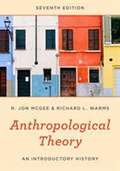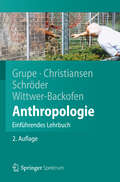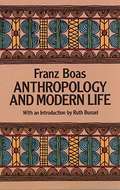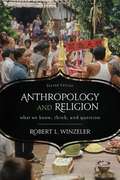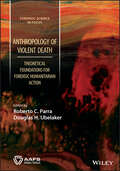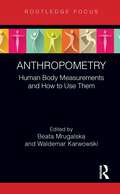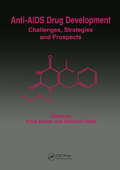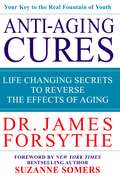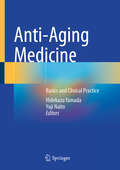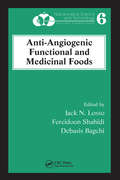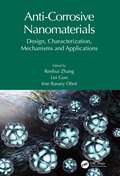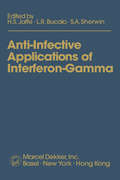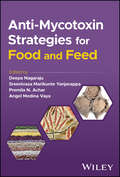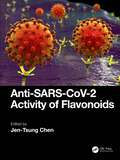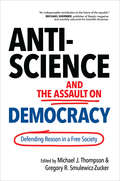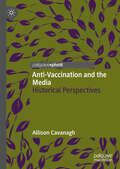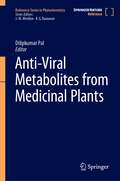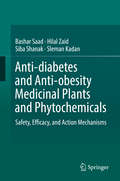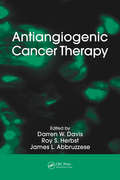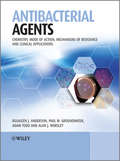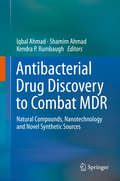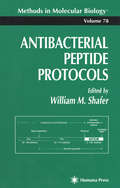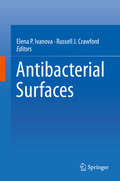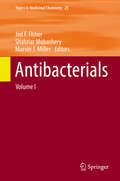- Table View
- List View
Anthropological Theory: An Introductory History
by Richard L. Warms R. Jon McGeeAnthropological Theory: An Introductory History, Seventh Edition, presents a selection of critical essays in anthropology from 1860 to the present day. Classic authors such as Marx, Durkheim, Boas, Radcliffe-Brown, Benedict, Rappaport, Geertz, and Turner are joined by contemporary thinkers including Das, Ortner, Kwiatkowski, and Mattingly. Detailed introductions examine critical developments in theory, introduce key people, and discuss historical and personal influences on theorists. In extensive footnotes, the editors provide commentary that puts the writing in historical and cultural context, defines unusual terms, translates non-English phrases, identifies references to other scholars and their works, and offers paraphrases and summaries of complex passages. The notes identify and provide background information on hundreds of scholars and concepts important in the development of anthropology. This makes the essays more accessible to both students and current day scholars. An extensive index makes this book an invaluable reference tool.
Anthropologie: Einführendes Lehrbuch (Springer-Lehrbuch)
by Gisela Grupe Inge Schröder Kerrin Christiansen Ursula Wittwer-BackofenAnthropologie, wörtlich übersetzt "die Lehre vom Menschen", ist eine primär biologische Disziplin - mit vielfältigen kulturwissenschaftlichen Bezügen. In diesem aktuellen Lehrbuch zur Anthropologie reduzieren die Autorinnen deshalb die Biologie des Menschen nicht auf eine Zoologie des Menschen, sondern beziehen seine kulturelle Überformung mit ein. Der Band bietet eine Einführung in die wichtigsten Fragen und ist daher besonders für das Grundstudium geeignet. Für die Neuauflage wurden nahezu alle Kapitel erheblich erweitert und aktualisiert.
Anthropology and Modern Life
by Franz BoasThe great anthropologist's classic treatise on race and culture. Discusses biological and cultural inheritance, the fallacy of racial, cultural or ethnic superiority, the scientific basis for human individuality, and much more. One of the most influential books of the century, now in a value-priced edition. Introduction by Ruth Bunzel.
Anthropology and Religion
by Robert L. WinzelerDrawing from ethnographic examples found throughout the world, this revised and updated text offers an introduction to what anthropologists know or think about religion, how they have studied it, and how they have interpreted or explained it since the late nineteenth century. Robert Winzeler's balanced consideration of classic topics, basic concepts, and new developments in the anthropological study of religion moves beyond cultural anthropology and ethnography to gather information from physical anthropology, prehistory, and archaeology. Written as a sophisticated but accessible treatment of the issues, Anthropology and Religion is a key text for upper-division courses.
Anthropology in the Anthropocene: An Earthed Theory for Our Extended Present (Anthropocene – Humanities and Social Sciences)
by Christoph AntweilerIn this book, anthropologist and geologist Christoph Antweiler shows that geology is a special, namely historical, natural science and is therefore relevant for a historically informed anthropology. He argues that we do not only need a geologically informed cultural anthropology, but conversely also an anthropologically oriented geology. A comprehensive geology must include material human culture as a fundamental geological phenomenon. In relation to cultural anthropology, the author discusses the challenge the Anthropocene poses for cultural anthropology as a traditionally micro-oriented social science. The book discusses where the blind spots lie in the highly interdisciplinary discussion. Common narratives are critically scrutinized. The author argues for the need for a new discipline: geoanthropology.
Anthropology of Violent Death: Theoretical Foundations for Forensic Humanitarian Action (Forensic Science in Focus)
by Roberto C ParraThe first book to specifically focus on the theoretical foundations of humanitarian forensic science Anthropology of Violent Death: Theoretical Foundations for Forensic Humanitarian Action consolidates the concepts and theories that are central to securing the posthumous dignity of the deceased, respecting their memories, and addressing the needs of the surviving populations affected. Focusing on the social and cultural significance of the deceased, this much-needed volume develops a theoretical framework that extends the role of humanitarian workers and specifically the actions of forensic scientists beyond an exclusively legal and technical approach. Anthropology of Violent Death is designed to inspire and alerts the scientific community, authorities, and the justice systems to think and take actions to avoid the moral injury in society and cultures due to grave disrespect against humanity, its memories and reconciliation. Humanitarian forensic science faces the role of mediator between the deceased and those who are still alive to guarantee the respect and dignity of humanity. Contributions from renowned experts address post-mortem dignity, cultural perceptions of violent death and various mortuary sites, the forms and critical effects of the so-called forensic turn and humanitarian action, the treatment of violent death in post-conflict societies, respect for the dead under International Humanitarian Law (IHL) and Islamic law, the ethical management of the death of migrants, and much more. In an increasingly violent world, this volume, develops a theoretical component for death management in scenarios where humanitarian action is required Facilities better understanding between the social sciences, the forensic sciences, and justice systems in situations involving violent death Discusses the latest theories from leading scholars and practitioners to enhance the activities of forensic scientists and authorities who have the difficult responsibility of making decisions It provides a better understanding of the humanitarian and cultural dilemmas in the face of violent death episodes, and the unresolved needs of the dignity of the deceased during armed conflicts, disasters, migration crises, including everyday homicides Anthropology of Violent Death: Theoretical Foundations for Forensic Humanitarian Action is an indispensable resource for forensic scientists, humanitarian workers, human rights defenders, and government and non-governmental officials.
Anthropometry: Human Body Measurements and How to Use Them (Body of Knowledge in Human Factors and Ergonomics)
by Waldemar Karwowski Beata MrugalskaToday, human factors and ergonomics professionals worldwide contribute to the design and evaluation of tasks, jobs, products, environments, and systems in order to make them compatible with the needs, abilities, and limitations of people. By understanding anthropometry, professionals can ensure that our home and working environments are comfortable and designed with the human in mind. This book aims to show how an understanding of anthropometrics can influence workspace design, ergonomics in the office, ergonomics in the home, and health and safety at work. This book discusses the measurement of the human body and human variability. Anthropometry may seem to be relatively simple but the reality is that it focuses on very sophisticated aspects of how to make the products tailor-made to suit specific requirements. As a study, it is useful for a variety of purposes such as workspace design, ergonomics in the office, ergonomics in the home, and health and safety at work. These eleven chapters investigate anthropometrics and bridge the gap between theory and practice. Each chapter is supported by tables, charts, and illustrations, and a wide list of bibliographic references. The reader will develop new insights into the principles and practice of anthropometrics with this book bringing the topic right up to date. Anthropometry: Human Body Measurements and How to Use Them will be of interest to students, graduates, teachers, researchers, and general workers in industrial design, ergonomics, rehabilitation, safety, and health.
Anti-AIDS Drug Development
by Prem Mohan Baba MasanoriThis book covers the major arenas of drug development, providing understanding of the pros and cons of the various efforts of chemists and biologists to explore newer antiviral targets for HIV replication and to look for and design molecules that will have minimal toxicities.
Anti-Aging Cures
by Dr James Forsythe Foreward by Suzanne SomersAre you tired of searching for the fountain of youth? Well, look no more. In this book, Nevada medical oncologist Dr. James Forsythe, one of the worldOCOs leading anti-aging experts, reveals how to slow and even reverse the aging process. Based on meticulously researched clinical evidence, this book provides an account of revolutionary anti-aging treatments that can prevent the health conditions associated with getting old. The key to youth, good health, and vitality as we age comes from our bodyOCOs Master Hormone that naturally produces human growth hormone (HGH ). As we advance in years, the body produces less and less of this vital hormone and we begin to see and feel symptoms of the aging process. By rejuvenating the Master Hormone gland using a range of safe and natural Bio-Stimulators, as this book shows, we improve the quality and duration of the human lifespan, prevent heart disease and obesity, and maintain optimal health as we mature. The medically documented and proven benefits include: loss of body-fat mass, improved skin texture and tone, improved bone density, improved libido and sleep quality, and much more. Dr. Forsythe, who wrote the official United States government protocol for administering growth hormone to fight aging, describes how readers can harness the power of Bio-Stimulators safely, legally, and naturally, to combat the ravages of aging. The book also describes simple ways to release more growth hormone in your body by using combinations of everyday foods, exercise, and quality sleep. Backed by firm medical science evidence, Anti-Aging Cures will teach you how all of these natural cures for aging work their magic on the human body. "
Anti-Aging Medicine: Basics and Clinical Practice
by Hidekazu Yamada Yuji NaitoThis textbook considers aging a disease and summarizes the leading-edge research and fact on anti-aging medicine and the aging mechanism. It provides the basics and biology of aging science, followed by presenting clinical studies such as exercise, nutrition, mental health (brain, sleep), and treatment interventions. The book also discusses aging control and considers behavioral, environmental, and societal implications for healthy aging. The field of aging science is interdisciplinary, and there are much more uncertainties; thus, it is crucial to summarize what is currently known to set a foundation for future research. The International Classification of Diseases by the World Health Organization (WHO) has given the aging-related disease a subcode of XT9T. This trend advanced research of aging-related sicknesses and the concept that infirmities associated with old age can be controlled, such as cancer, dementia, and cardiovascular diseases. Basic research has progressed, and clinical applications have become available, resulting in significant social changes. As increased life expectancy is happening over the globe, we are facing unprecedented challenges, and anti-aging medicine is a key to treating population growth, environmental problems, etc., as problems for the entire planet. Anti-Aging Medicine: Basics and Clinical Practice is an English translation of the publication by the Japanese Society of Anti-Aging Medicine. It is an insightful source for healthcare professionals and scholars in anti-aging and geriatrics. It will attract pharmaceutical, Information Technology, and Artificial Intelligence industries associated with aging-responsive markets. The English translation of this book, originally in Japanese, was facilitated by artificial intelligence. A subsequent human revision of the content was done by the editors and authors.
Anti-Angiogenic Functional and Medicinal Foods
by Fereidoon Shahidi Debasis Bagchi Jack N. LossoThe ability to regulate and manipulate the generation or remodeling of blood vessels is key to the successful treatment of many chronic diseases, both oncological and non-oncological. Several bioactive compounds present in human diets are now known to exert an inhibitive effect on the either the signaling or construction of new blood vessels. The i
Anti-Corrosive Nanomaterials: Design, Characterization, Mechanisms and Applications
by Lei Guo Renhui Zhang Ime Bassey ObotCorrosion is a great challenge in many industries, especially in the automotive, aerospace, and oil and gas industries, with conservative estimations accounting for losses of around 2.2 trillion US dollars per year in the United States alone. Providing a comprehensive overview of the history and development of nanomaterials, this book discusses various practices for protection against corrosion. Key Features: Provides a comprehensive and updated review of major innovations in the field of nanomaterials in industrial, corrosion, and environmental science and engineering Encompasses design, characterization, mechanism, and application of nanomaterials from different strategies on the efficacy and major challenges associated with successful scaleup designing Essential reference for present and future research in nanomaterials Includes relevant aspects of organic and inorganic nanomaterials, hybrid nanomaterials, and nanocoatings in anticorrosion applications Coalescing a wide range of research on nanomaterials and anticorrosion practices, this book is of particular appeal to students, industry professionals, and academics.
Anti-Infective Applications of Interferon-Gamma
by Howard S. JaffeThis reference spotlights the immunologic aspects of applying interferon-gamma to the treatment of infectious diseases - revealing the current knowledge of the biology and potential utility of interferon-gamma.;Written by more than 30 leading investigators in the field, Anti-Infective Applications of Interferon-Gamma: presents information according to specific patient populations and pathogens; focuses on only the most promising of emerging therapeutic agents; furnishes a detailed update of the pleiotropic role of interferon-gamma in host defense; and studies clinical and preclinical experiences in a broad variety of disease indications.;Containing over 900 bibliographic citations for further research, this book should be useful for infectious disease specialists, pharmacologists, immunologists, surgeons, pediatricians, parasitologists, hematologists, virologists, microbiologists, pathologists, oncologists and tropical medicine specialists.
Anti-Mycotoxin Strategies for Food and Feed
by Deepa Nagaraju Sreenivasa Marikunte Yanjarappa Premila N. Achar Angel Medina VayaAnti-Mycotoxin Strategies for Food and Feed Up-to-date information on mycotoxigenic fungi and toxins, with methods to control them in food and feed Anti-Mycotoxin Strategies for Food and Feed focuses on strategies to control the health risk of mycotoxins associated with cereals, pulses, and vegetables during post and pre harvest stages, in addition to foods, food-based products, and feeds. Each chapter is carefully designed to offer information elucidating various strategies, which include physical, chemical, and biological methods. The book provides a combined approach of advanced techniques used against mycotoxigenic fungi, which is helpful in studying the strategies for different mycotoxins. Special attention has been paid to diseases caused by mycotoxigenic fungi and their destructive effect on either preharvest, post-harvest, or storage, and their respective toxins which pose a long-term health risk to humans and animals, if contaminated food or feed enter our food chain. The primary focus of the text is on the recent and advanced approaches and strategies including control, detoxification, degradation and binding methods, with graphical representations of protocols with supporting tables and figures. Anti-Mycotoxin Strategies discusses specific sample topics such as: Advanced anti-fumonisin strategies and strategies for the control of aflatoxigenic Aspergillus species in contaminated food and feed Innovative strategies to decontaminate Ochratoxin A and Zearalenone. Effects of toxic citrinin, patulin and Ergot alkaloids in animals, birds, and humans, and effective mitigation strategies as its control measures. Detoxification and Decontamination strategies of Deoxynivalenol an emetic toxin, Trichothecenes, T-2/HT-2 toxin and nivalenol associated in food and feed as contaminants. Presenting and discussing mycotoxin management strategies at length and enabling readers to reduce or eliminate health hazards to humans and animals, Anti-Mycotoxin Strategies is an essential resource for mycologists, mycotoxicologists, Microbiologists, Food technology professionals in the food, seed, and feed industries, scientists, students, researchers, and farmers / agriculturists.
Anti-SARS-CoV-2 Activity of Flavonoids
by Jen-Tsung ChenIn the past years, COVID-19 caused millions of deaths and severely damaged not only public health, but also the global economy. New variants continue to threaten human health. Thus, natural compounds for retarding infection are in high demand. This book summarizes the emerging research with flavonoids, whose application holds great promise of antivirus, anti-inflammation, antioxidative stress, and immunomodulatory. Topics include the role of flavonoids in preventing an inflammatory storm and how flavonoids interact with critical protein targets that are involved in the infection stages of COVID-19.Key Features• Highlights anti-SARS-CoV-2 drug discovery on natural products and medicinal plants• Includes all major subclasses of flavonoids that promisingly combat COVID-19 • Proposes molecular mechanisms of flavonoids against protein targets of SARS-CoV-2• Contributions from an international team of leading researchers• Provides recommendations with respect to the future research
Anti-Science and the Assault on Democracy: Defending Reason in a Free Society
by Michael J. Thompson Gregory R. Smulewicz-ZuckerDefending the role that science must play in democratic society--science defined not just in terms of technology but as a way of approaching problems and viewing the world.In this collection of original essays, experts in political science, the hard sciences, philosophy, history, and other disciplines examine contemporary anti-science trends, and make a strong case that respect for science is essential for a healthy democracy. The editors note that a contradiction lies at the heart of modern society. On the one hand, we inhabit a world increasingly dominated by science and technology. On the other, opposition to science is prevalent in many forms--from arguments against the teaching of evolution and the denial of climate change to the promotion of alternative medicine and outlandish claims about the effects of vaccinations. Adding to this grass-roots hostility toward science are academics espousing postmodern relativism, which equates the methods of science with regimes of "power-knowledge." While these cultural trends are sometimes marketed in the name of "democratic pluralism," the contributors contend that such views are actually destructive of a broader culture appropriate for a democratic society. This is especially true when facts are degraded as "fake news" and scientists are dismissed as elitists. Rather than enhancing the capacity for rational debate and critical discourse, the authors view such anti-science stances on either the right or the left as a return to premodern forms of subservience to authority and an unwillingness to submit beliefs to rational scrutiny. Beyond critiquing attitudes hostile to science, the essays in this collection put forward a positive vision for how we might better articulate the relation between science and democracy and the benefits that accrue from cultivating this relationship.
Anti-Vaccination and the Media: Historical Perspectives
by Allison CavanaghThis book explores narratives of vaccine hesitancy using samples from the UK press, and looks at the ways these have changed between the 1950s and the present. The work draws on a variety of research instruments including semantic network analysis and analysis of metaphor to provide a rich description of anti-vaccine narratives in different historical periods. The work considers the ways that concerns about and resistance to inoculation were informed by cultural and social pressures in two case studies, firstly that of polio in the 1950s and secondly the so called ‘pertussis crisis’ of the 1970s, wherein a period of social activism and newspaper campaigning led UK and US governments to offer compensation schemes for vaccine damaged children. The studies chosen provide a detailed comparison of the politics of childhood inoculation over two eras in the UK. Chapters also cover the use of metaphor and representational analysis in health communication, comparing ways in which the work of Moscovici, Sontag and other theorists can be used to provide complementary insights, and the affordances and concerns around the use of ‘big data’ analyses in historical work. The work also features discussion of the implications of the findings for approaches to more recent vaccination crisis points. This book argues that anti-vaccination narratives, far from showing a stable and coherent set of concerns, are highly mutable. The work compares anti-vaccination and conspiracy theory narratives, drawing out areas of continuity and schism.
Anti-Viral Metabolites from Medicinal Plants (Reference Series in Phytochemistry)
by Dilipkumar PalThis reference work covers general concepts of anti-viral metabolites, classifications, ethnopharmacology, chemistry, clinical and preclinical studies focusing on different medicinal plants against various types of viral infections. Various plants have been used in medicine since ancient times and are known for their strong therapeutic effects. The book will describe potential antiviral properties of medicinal plants against a diverse group of viruses, and provide an insight to the potential plants possess for broad-spectrum antiviral effects against emerging viral infections. The book aims to target a broad audience including virologists, molecular biologist, microbiologist and scientists working with natural products as well as researchers, students, healthcare experts involved in pharmaceutical and medical field.
Anti-diabetes and Anti-obesity Medicinal Plants and Phytochemicals: Safety, Efficacy, and Action Mechanisms
by Bashar Saad Hilal Zaid Siba Shanak Sleman KadanThis work presents a systematic review of traditional herbal medicine and their active compounds, as well as their mechanism of action in the prevention and treatment of diabetes and obesity. The side effects and safety of herbal-derived anti-diabetic and anti-obesity phytochemicals are detailed in depth, and the text has a strong focus on current and future trends in anti-diabetic medicinal plants. This unique and comprehensive text is the only current book on the market focusing exclusively on medicinal plants used to combat obesity and diabetes. An introductory chapter focuses on diabetes and obesity and introduces the major causes and main treatments of this increasing epidemic in modern society. Readers are then introduced to medicinal plants, including details on their therapeutic aspects, plus side effects and safety. Following chapters focus on anti-diabetic and anti-obesity medicinal plants, as well as phytogenic natural products in the treatment of each. The text closes by focusing on present and future trends and challenges in these medicinal plants. Anti-diabetes and Anti-obesity Medicinal Plants and Phytochemicals: Safety, Efficacy, and Action Mechanisms is a much-needed and truly original work, finally presenting in one place all the necessary information on medicinal plants used in conjunction with obesity and diabetes prevention.
Antiangiogenic Cancer Therapy
by James L. Abbruzzese Roy S. Herbst Darren W. DavisTop Investigators Explore the Complexities of Angiogenesis Cancer ResearchThe targeting of tumor angiogenesis has evolved into one of the most widely pursued therapeutic strategies. However, as of yet, no antiangiogenic agent used as a monotherapy has demonstrated a survival benefit in a randomized Phase III trial. The combination of bev
Antibacterial Agents
by Paul Groundwater Rosaleen Anderson Alan Worsley Adam ToddAntibacterial agents act against bacterial infection either by killing the bacterium or by arresting its growth. They do this by targeting bacterial DNA and its associated processes, attacking bacterial metabolic processes including protein synthesis, or interfering with bacterial cell wall synthesis and function.Antibacterial Agents is an essential guide to this important class of chemotherapeutic drugs. Compounds are organised according to their target, which helps the reader understand the mechanism of action of these drugs and how resistance can arise. The book uses an integrated "lab-to-clinic" approach which covers drug discovery, source or synthesis, mode of action, mechanisms of resistance, clinical aspects (including links to current guidelines, significant drug interactions, cautions and contraindications), prodrugs and future improvements.Agents covered include:agents targeting DNA - quinolone, rifamycin, and nitroimidazole antibacterial agentsagents targeting metabolic processes - sulfonamide antibacterial agents and trimethoprimagents targeting protein synthesis - aminoglycoside, macrolide and tetracycline antibiotics, chloramphenicol, and oxazolidinonesagents targeting cell wall synthesis - β-Lactam and glycopeptide antibiotics, cycloserine, isonaizid, and daptomycinAntibacterial Agents will find a place on the bookshelves of students of pharmacy, pharmacology, pharmaceutical sciences, drug design/discovery, and medicinal chemistry, and as a bench reference for pharmacists and pharmaceutical researchers in academia and industry.
Antibacterial Drug Discovery to Combat MDR: Natural Compounds, Nanotechnology and Novel Synthetic Sources
by Iqbal Ahmad Kendra P. Rumbaugh Shamim AhmadThis book compiles the latest information in the field of antibacterial discovery, especially with regard to the looming threat of multi-drug resistance. The respective chapters highlight the discovery of new antibacterial and anti-infective compounds derived from microbes, plants, and other natural sources. The potential applications of nanotechnology to the fields of antibacterial discovery and drug delivery are also discussed, and one section of the book is dedicated to the use of computational tools and metagenomics in antibiotic drug discovery. Techniques for efficient drug delivery are also covered. The book provides a comprehensive overview of the progress made in both antibacterial discovery and delivery, making it a valuable resource for academic researchers, as well as those working in the pharmaceutical industry.
Antibacterial Peptide Protocols (Methods in Molecular Biology #78)
by William ShaferLeading experts review for the first time in one volume all the mjaor biochemical, molecular, bacteriological, and physical techniques available to assess antimicrobial peptides. These state-of-the-art methods ensure easily reproducible results in such important procedures as the isolation and characterization of antimicrobial peptides, the molecular characterization of genes encoding antimicrobial peptides, and the use of expression systems to isolate peptides. Bioassays and microbial genetic techniques are also included, as are antibacterial assays as the final readout system.
Antibacterial Surfaces
by Elena Ivanova Russell Crawford'Antibacterial Surfaces' covers the advances being made in the design of antibacterial surfaces, which have the ability to either prevent the initial attachment of bacterial cells, or kill any cells that come into contact with these surfaces. This book discusses the mechanisms associated with the attachment of bacteria to surfaces and the main strategies currently being employed to control the initial attachment processes. These strategies are expanded upon in the subsequent chapters, where the definition and description of antibacterial surfaces are clarified, as are the mechanisms that come into play when determining the effectiveness of an antibacterial surface. Subsequent chapters discuss a number of naturally occurring antibacterial surfaces, the methods currently being used for producing synthetic antibacterial surfaces, and the current and potential applications of such materials. This book will be of great interest to people who work with materials that need to remain free of bacterial films, from designing safer biomedical implants to the production of self-cleaning materials where the prevention of biofilm formation has significant economic advantages.
Antibacterials: Volume I (Topics in Medicinal Chemistry #25)
by Jed F. Fisher Shahriar Mobashery Marvin J. MillerMedicinal chemistry is both science and art. The science of medicinal chemistry offers mankind one of its best hopes for improving the quality of life. The art of medicinal chemistry continues to challenge its practitioners with the need for both intuition and experience to discover new drugs. Hence sharing the experience of drug research is uniquely beneficial to the field of medicinal chemistry. Drug research requires interdisciplinary team-work at the interface between chemistry, biology and medicine. Therefore, the topic-related series Topics in Medicinal Chemistry covers all relevant aspects of drug research, e.g. pathobiochemistry of diseases, identification and validation of (emerging) drug targets, structural biology, drugability of targets, drug design approaches, chemogenomics, synthetic chemistry including combinatorial methods, bioorganic chemistry, natural compounds, high-throughput screening, pharmacological in vitro and in vivo investigations, drug-receptor interactions on the molecular level, structure-activity relationships, drug absorption, distribution, metabolism, elimination, toxicology and pharmacogenomics. In general, special volumes are edited by well known guest editors
